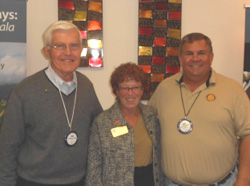Tuesday, October 29, 2013
Club Business Meeting

Ex-district governor Pam Kerr visited us and told us the latest about the digital X-Ray project.
Ex-district governor Pam Kerr visited us and told us the latest about the digital X-Ray project. The project is being run by a group of local clubs, District 4250 (comprising Belize, Guatemala, and Honduras), the Pan-American Health Organization, the Guatemalan Ministry of Public Health & Social Welfare, and the Radiological Society of Guatemala.
Managing the relationships and communications of so many parties can be complicated; a project like this takes years, bureaucracies can be slow, and governments change. So, these parties have agreed to a memorandum of understanding that formalizes a partnership between them all.
Memoranda of understanding can be helpful, but so can Rotary club connections. Pam recounted a story of three component vendors squabbling over whose responsibility it was, when the first unit failed. A Rotarian who was attending a meeting with the head of Senecal, the Spanish supplier, mentioned the problem, which was promptly addressed.
The first digital x-ray machine is now installed, in the municipal building in Mixco, a community near Guatemala City. It took 3 years to accomplish this, and there are 29 more machines to go, for this particular phase of the project, intended to bring digital x-ray technology to the poor of the world. Honduras has already said they'd like to be next, if this phase of the project can be brought to success.
The Park Ridge Rotary club had been supplying inexpensive x-ray machines that worked to poor countries. They wanted to try digital technology for its several advantages. For example, the x-ray can be taken/made by a high school graduate with 2 weeks' training, then the image may be viewed and analyzed by a radiologist anywhere in the world, for example in India.
To accomplish this takes many technical elements, not least, a good communications link. Also of course, electrical power. Getting it all together isn't simple or easy - these are 3rd world countries and "nothing works like you think."
The goal of this phase of the project is to make available to every resident of Guatemala, an x-ray machine that they may travel to in 5 hours or less. This simple availability, if achieved, will help people, not just with broken bones, but also with intestinal blockages and other conditions. It can mean the difference between life and death, but also, between a healthy, productive life in which a recovered patient provides for his/her family and contributes to their community, as opposed to being crippled for life.
The next 29 machines will cost $70,000 each and funds still need to be raised; the Guatemalans are providing the facilities & electricity. If the project succeeds, 1.4 million people will benefit.
We thank Pam Kerr for her dedicated effort and for visiting us to tell us all about this project.
